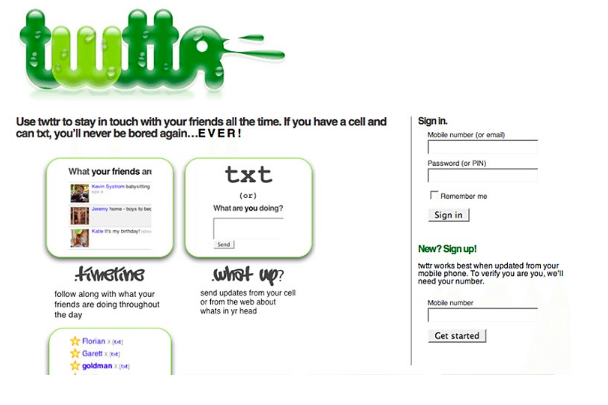MVP EXAMPLES
A Minimum Viable Product is the first version of a product; here are MVPs of some startups you may recognize.
FACEBOOK | All Facebook's (or Thefacebook as it was called when they launched) MVP did was connect students together via their college or class and let them post messages to their boards. The idea already existed in Friends Reunited and other social platforms, but the simplicity of Facebook’s approach and the traction it gained in the virulent world of college graduates proved unstoppable. This allowed almost all of the features that came after to build on that success.
AMAZON | Amazon started off selling books online, challenging the Barnes and Nobles of this world who were largely stuck in the bricks-and-mortar age. Focusing on the books at a low prices angle in 1994 with a simplistic web design was all it took for the company to grow and branch out to become the retail leviathan it is today.
TWITTER | After Apple released iTunes, a podcasting platform, Odeo, experienced tough times and they were forced to organize hackathons, trying to figure out what to do next. During one of their hackathons, they came up with an idea to create an SMS-based platform. It was initially known as “twttr”, and was a product for internal use only. However, employees were spending several dollars on SMS to post to the platform, in order to test it among users. Finally, Twitter was released to the public in 2006, a year later it was a hit. Twitter increased its userbase, and became the second most popular social networking site after Facebook.
GROUPON | Vouchers and discounts are old concepts, but Groupon took the idea of sharing and socializing them to new heights. It launched with a simple WordPress site and regular PDFs emailed to early subscribers. The test proved successful, and the company then built its voucher system and backend, driving it to a great success.
AIRBNB | Cutting out the middleman and providing short-term renting is the key mission statement behind Airbnb. Brian Chesky and Joe Gebbia lived in a loft apartment in San Francisco and had difficulties with paying their rent. That's when they decided to give it a try and fulfill one of their dreams to start a business. To test the idea they provided accommodation for those who came to town to attend a design conference. Brian and Joe took a few pictures of their loft, created a simple web page and soon enough had 3 paying guests. Airbnb expanded organically, with founder Paul Chesky living exclusively in Airbnbs to dog food the product.
PEBBLE | The smartwatch market is slowly gaining traction, but Pebble proved that cramming massive amounts of tech into a coin-sized space isn’t a prerequisite for success. Its e-paper-based original design raised $10 million on Kickstarter, with backers proving the concept was something people really wanted. The company demonstrated repeatability with the Pebble Time raising over $20 million in 2015. Yes, Pebble retired from the market last year, but it proved with millions of sales that not everyone needs the fastest and latest tech.
ZAPPOS | What if you can’t get inventory for your site? Zappos' founder Nick Swinmurn went into shoe retailing with no stock. He took photos of shoes he wanted to sell in stores and if customers ordered them, he then physically purchased the product and sold them on. That’s a great way to test a market if you don’t have access to the product, but have an MVP model you think will succeed.
ETSY | This craft-focused site let eBay do the proof of concept and then found an audience that needed their own MVP to resonate with. Craft sales have boomed since, as Etsy focused on small bespoke crafters and their products. All based on seeing where eBay succeeded and where it let sellers down.
DROPBOX | Dropbox decided to go even further and didn’t make any product at all. Instead, they pretended they had it ready by creating an explainer video. They wanted to check if their file-syncing idea is anywhere close to being interesting to people. They could've built a whole hardware infrastructure, develop apps and so on, but that was a risk they weren't willing to take. If the idea would have failed, Dropbox founders Arash Ferdowsi and Drew Houston would lose priceless time, a lot of effort and money. Overnight they attracted over 70k of people who left their emails and wanted to get the products as soon as possible. I don’t need to tell you how it ended, do I? ;)
BUFFER | Buffer is a social media tool that lets you schedule posts on different social media platforms like Twitter, Facebook, LinkedIn, Pinterest, Google+ or Instagram. The CEO of Buffer, Joel Gascoigne, decided that he doesn’t want to build a product that no one's going to use. So they did something similar to what Dropbox did, just instead of a video, they created a landing page that would present the idea of Buffer product to visitors, show them different pricing and features. If someone was convinced enough to proceed with purchasing the product and picked one of the available plans - they’d get a screen informing them that Buffer was not fully ready yet, but they could subscribe to the waiting list. Later, Buffer used emails they received to talk to those people and ask them about their expectations etc. This approach helped them to build a product the market actually wanted.
FOURSQUARE | One of the great examples of a single-featured MVP is a location-based social platform - Foursquare. Dennis Crowley and Naveen Selvadurai weren’t new to the business world. Before they founded Foursquare they had developed another similar platform - Dodgeball, which was eventually sold to Google. So when they moved to a new project they knew exactly what they should be doing. Dennis and Naveen started building an MVP with limited functionalities. It allowed you to check-in into different locations and would award you with different badges as a part of their gamification process. Only after the MVP became successful they added more features, transforming it into a sophisticated city guide.
SPOTIFY | Spotify is another great example of how implementing only one core feature, instead of getting distracted by different cool features it would be nice to have in your MVP, can help you to succeed. They wanted to build the best music streaming service and for their MVP they concentrated on a single most important feature - music streaming. Spotify developed a desktop app and run a closed beta to test the market. While the MVP product and a freemium price model was proving to be exactly what people wanted, Spotify team spent time on signing even more artists, simultaneously developing mobile apps and going overseas to conquer the US market.
UBER | You might be surprised, but if you didn’t follow Uber’s history since the very beginning, you might not know that back in 2010 Uber wasn’t what you’d expect it to be. Uber’s MVP did one simple thing: connected drivers with iPhone owners in San Francisco who weren't scared to have credit card payments enabled in an unknown app. It was enough to fulfill their main goal: offer taxi services as cheap as possible. The Uber we know now is a result of a right approach to business scaling and a successful MVP test.













